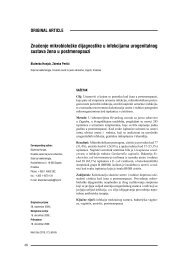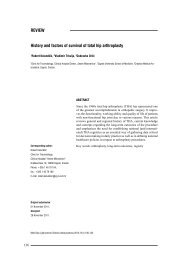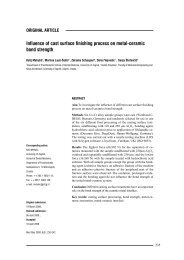MEDICINSKI GLASNIK
MEDICINSKI GLASNIK
MEDICINSKI GLASNIK
You also want an ePaper? Increase the reach of your titles
YUMPU automatically turns print PDFs into web optimized ePapers that Google loves.
24<br />
Medicinski Glasnik, Volumen 9, Number 1, February 2012<br />
INTRODUCTION<br />
Significant technological advances in recent years<br />
have enabled the development of wireless<br />
sensor networks (WSN) as a new technology<br />
with wide application possibilities (1, 2). For the<br />
development of WSN, the advances in the area of<br />
microelectronics, wireless communications, micro-electro-mechanical<br />
systems (MEMS) and the<br />
sensing technology have been most significant.<br />
Such advances have enabled the development of<br />
the low-cost miniature intelligent sensor nodes,<br />
which are capable of mutual wireless communication.<br />
Sensor nodes can be equipped with different<br />
sets of nodes, depending on the specific application.<br />
Every sensor node is capable of sensing, data<br />
processing and wireless communication with<br />
neighbouring sensor nodes and/or other devices<br />
(e.g. base station). Such sensor networks can be<br />
seamlessly integrated in other network structures,<br />
such as wireless personal-area (WPAN) or<br />
wireless body-area networks (WBAN).<br />
Wireless sensor networks have quickly become<br />
a widely adopted technology and found many<br />
possible applications (3). Medical applications<br />
of the wireless sensor networks are one of the<br />
most promising areas for their practical use (4,<br />
5). There are many research efforts worldwide<br />
that are focused on the development of the reliable,<br />
flexible and inexpensive WBAN network<br />
suitable for medical applications (6, 7). Research<br />
efforts resulted in certain prototypes of wireless<br />
networks specialized for medical applications (8,<br />
9, 10, 11). Some of these prototypes could become<br />
accepted and used in practice worldwide.<br />
The authors analyze the current status of the research<br />
of medical wireless sensor networks. This<br />
paper surveys the current projects and prototypes<br />
of this area. The authors also propose the general<br />
system architecture for the realization of medical<br />
sensor networks including the model for hardware<br />
and software organization. Adherence to the<br />
general widely accepted system architecture should<br />
ensure the interoperability and interconnectivity<br />
among different medical systems based on<br />
wireless sensor networks (12, 13, 14). Finally, the<br />
paper analyzes the future development directions<br />
and possible benefits obtained by the implementation<br />
of the advanced medical systems based on<br />
sensor networks.<br />
WIRELESS SENSOR NETWORKS<br />
In the last decade, a new technology of wireless<br />
sensor networks (WSN) has emerged and become<br />
rapidly accepted and outspread worldwide.<br />
The most important prerequisites for the WSN<br />
development have been the advances in MEMS,<br />
wireless communications, microelectronics, embedded<br />
computing and sensing technology. These<br />
technological advances led to the development of<br />
the miniature multifunctional low-cost wireless<br />
sensor node which is equipped with data processing,<br />
storage, transceiver, power supply and sensing<br />
unit. The architecture of the typical sensor<br />
node is given in the Figure 1.<br />
The data processing unit generally consists<br />
of the CPU (Central Processing Unit) and the<br />
associated storage unit. This unit coordinates all<br />
tasks related to the sensing and inter-node collaboration<br />
and communication. The transceiver<br />
unit enables mutual wireless communication<br />
between sensor nodes, such as the communication<br />
between nodes and base station. The battery<br />
is usually used as the power supply unit, although<br />
in some cases it can be extended with some<br />
energy scavenging unit (e.g. solar cells) or the<br />
power generator. The sensor node can also be<br />
extended with other optional application dependent<br />
units, such as the location finding system.<br />
The sensing unit usually consists of two main<br />
components: sensors and analog to digital converters<br />
(ADC).<br />
The dispersed sensor nodes constitute the sensor<br />
field and form the multihop infrastructureless<br />
architecture. Each sensor node from the sensor<br />
field is capable of collecting data and routing<br />
them to the sink (base station). The data sink is<br />
connected to the end user or to the task manager<br />
node locally or remotely, via the Internet, GSM<br />
or other global network. The typical architecture<br />
of the sensor network is shown in Figure 2.<br />
Figure 1. The architecture of the sensor node (Grgić K., 2011)












